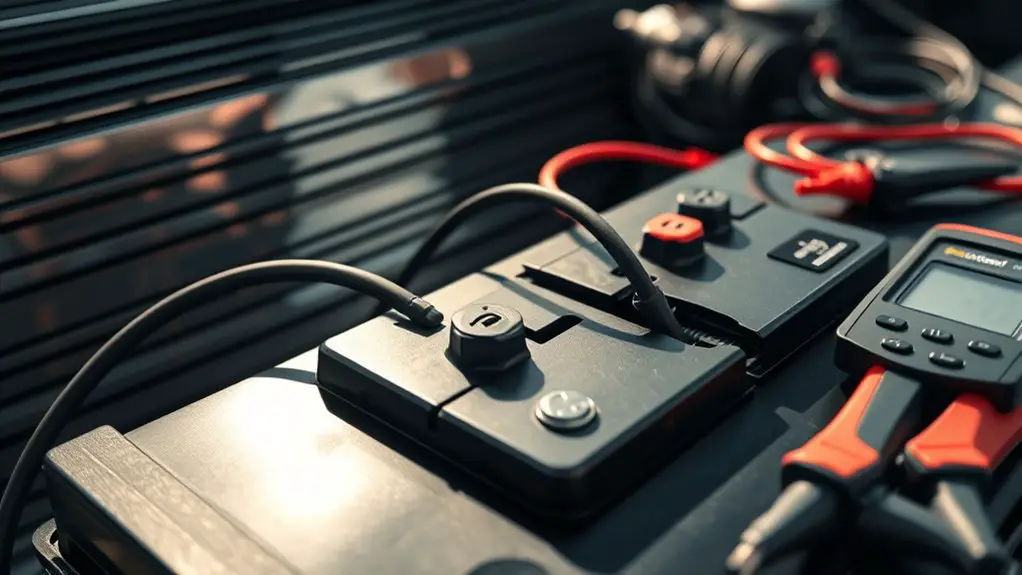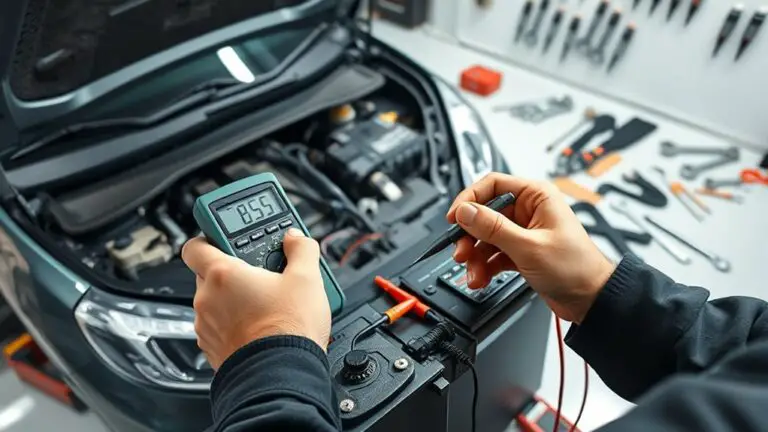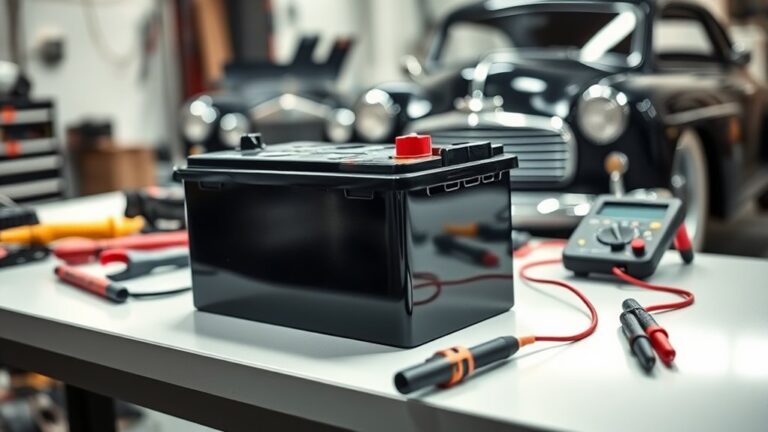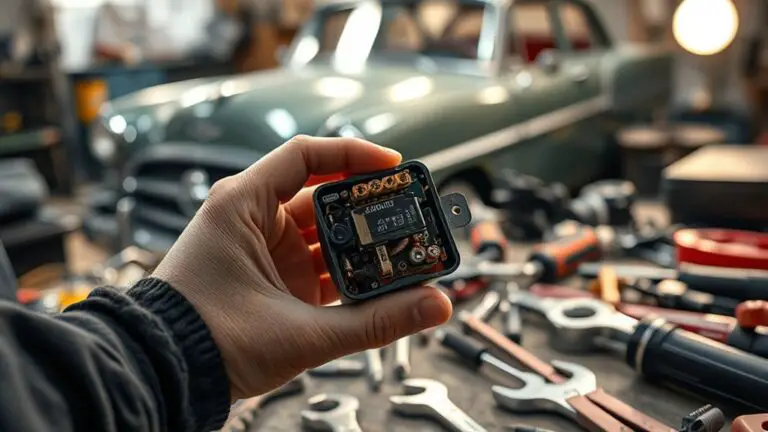Charging Tips to Avoid Inverter Fault and Extend Battery Life
To avoid inverter faults and extend battery life, match your charger output to your battery type (lead-acid, gel/AGM, or lithium) and use proper charging stages (bulk, absorption, float) with safeguards like current limits and temperature compensation. Manage depth of discharge by staying within low DoD to reduce stress, and avoid deep cycles. Control temperature during charging and storage, minimize voltage spikes, and schedule maintenance charging. By following these practices, you’ll see longer life and fewer faults; more guidance awaits.
Matching Charger Output to Battery Type
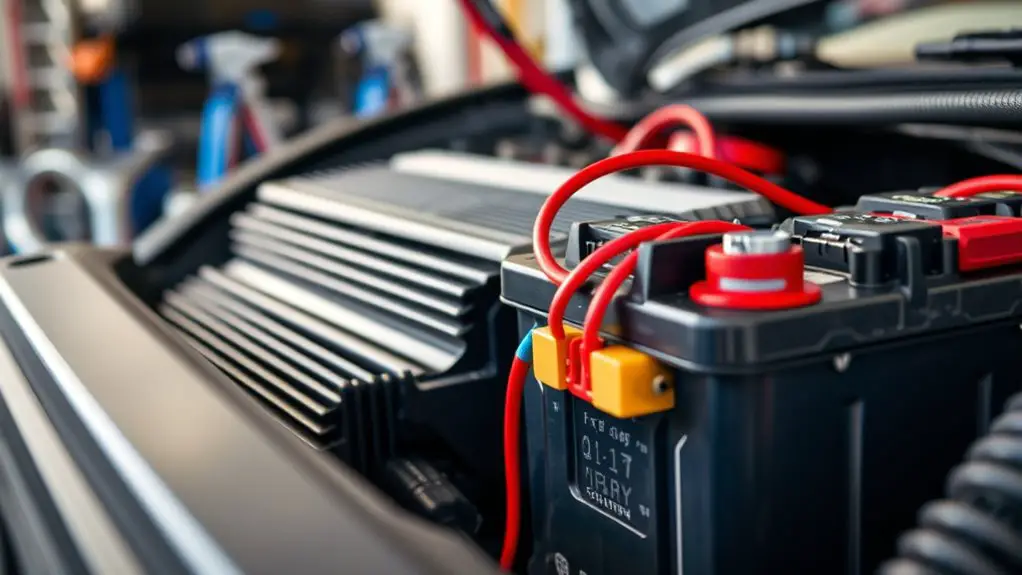
Ensuring the charger output matches your battery type is essential for ideal performance and longevity. You’ll want to verify charger compatibility by checking voltage, current, and end-of-charge behavior against your battery chemistry. Different chemistries tolerate different charging profiles: lead-acid, gel, AGM, and lithium variants each have distinct termination voltages and float needs. When you select a charger, confirm it supports the correct charging stages and safeguards, such as voltage taper, current limit, and temperature compensation. Misalignment can cause excessive gassing, plating, or thermal stress, reducing capacity and life. Prioritize chargers that document the exact charge profile for your battery chemistry and provide automatic mode switching for bulk, absorption, and float phases. Keep your charger within the manufacturer’s recommended range, and avoid adapting chargers beyond their specified parameters. This approach preserves efficiency, minimizes aging, and sustains peak availability. Remember, proper charger compatibility directly influences reliability and total system freedom.
Understanding Depth of Discharge and Its Limits
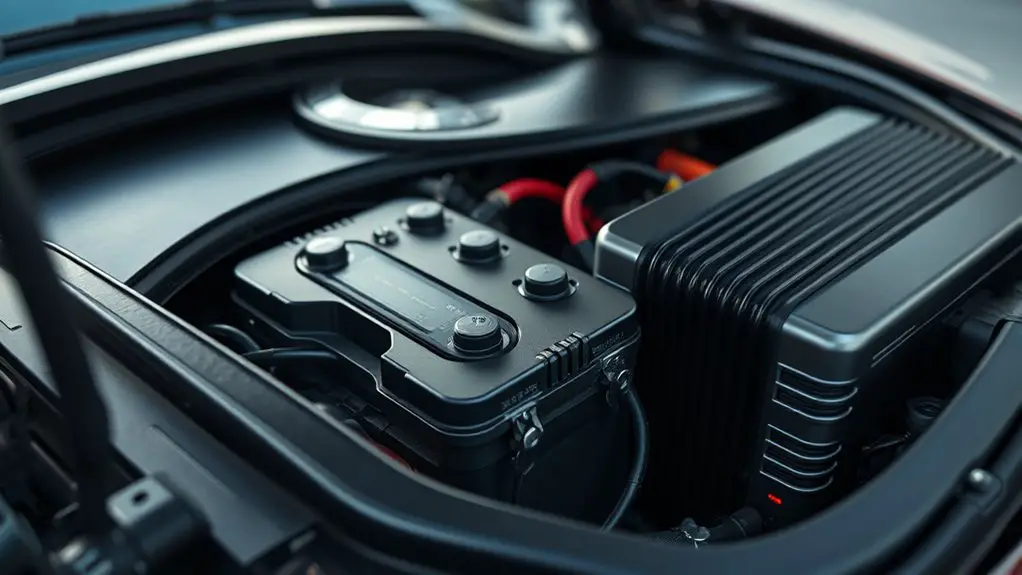
Depth of discharge (DoD) quantifies how much of a battery’s capacity is used relative to its total usable capacity. You’ll measure DoD as a percentage of the rated capacity you actually draw during a discharge cycle. A lower DoD means smaller energy reduction per cycle, which generally reduces stress on active materials and prolongs effective life. Conversely, high DoD values remove more energy per cycle, increasing chemical strain and accelerating degradation. Understanding this balance helps you optimize discharge cycles for your application while preserving battery longevity. Note that DoD interacts with chemistry and construction: lead-acid systems tolerate deeper cycles less gracefully than many lithium chemistries, which tolerate higher DoD with proper management. Set target DoD limits that align with your duty cycle, storage expectations, and inverter load profiles. Maintain consistent DoD boundaries to minimize capacity fade, reduce rate-dependent losses, and extend usable capacity over time. You’ll gain freedom through disciplined DoD management without unnecessary risk to system reliability.
Temperature Management for Charging and Storage
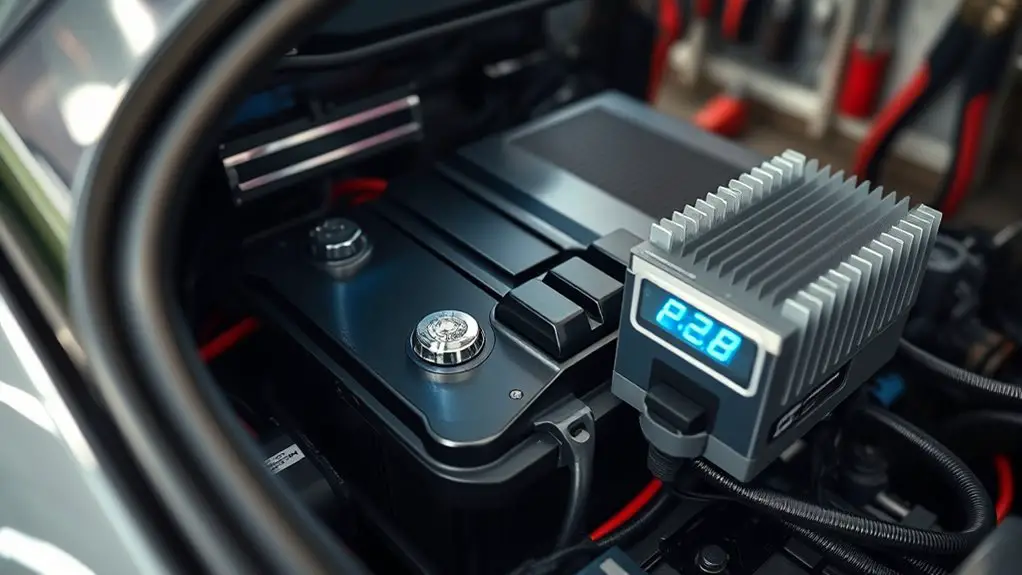
Temperature affects both charging efficiency and long-term battery health, so managing temperature during charging and storage is as important as controlling DoD. You’ll optimize performance by controlling the charging environment and monitoring temperature fluctuations to minimize stress on cells.
- Maintain a stable charging environment within the recommended range to reduce impedance rise and heat generation.
- Track temperature fluctuations and avoid rapid cycles that amplify degradation and capacity fade.
- Schedule charging during cooler periods or when ambient conditions are within spec to preserve chemistry.
- Use appropriate thermal management tools (cooling or insulation) to limit hotspots and maintain uniform cell temperatures.
Precise control reduces internal resistance, extends cycle life, and improves efficiency. You should implement a simple monitoring routine, verify sensor accuracy, and document excursions. By prioritizing consistent temperatures, you gain reliable performance, safer storage, and greater autonomy in your energy system.
Avoiding Voltage Spikes and Transients
To shield your inverter system from voltage spikes, implement robust surge protection and proper wiring practices. Smooth transient management helps maintain consistent charging voltages and reduces stress on battery cells. Start by detailing shield against spikes and refining transient response to prevent overvoltage events.
Shield Against Spikes
A voltage spike or transient can momentarily exceed the inverter’s rating, stressing components and shortening battery life; to shield the system, use surge protection devices, proper grounding, and rated cabling.
- Install properly rated surge protectors at the main panel and subpanels to absorb transient energy and preserve voltage regulation.
- Verify grounding integrity and bonding across enclosures, generators, and utility feeds to provide a low-impedance path for spikes.
- Use shielded, properly rated cables with adequate impedance and separation from high-current conductors to minimize coupling.
- Choose equipment with built-in surge protection and rapid response, ensuring compatibility with your inverter’s input characteristics and anticipated surge levels.
Smooth Transient Management
Smooth transient management focuses on preventing voltage spikes and rapid deltas from propagating through the inverter system, preserving battery health and uninterrupted operation. You’ll monitor transient response characteristics to guarantee circuit timings align with load changes, reducing overshoot and undershoot. Implement controlled ramping for power draw and charging currents, so the inverter can adapt without exciting resonance. Practice disciplined load management by prioritizing essential loads during surges and shedding noncritical ones, preventing sudden current demand from destabilizing the DC link. Use snubbers, proper decoupling, and EMI suppression only where specified, avoiding unnecessary losses. Verify that protection thresholds, fusing, and thermal limits remain aligned with real-world transients. Document responses to events, iterating setups to maintain margin while preserving system freedom and reliability.
Best Practices for Equalization and Maintenance Charging
In this section, you’ll review how to time and execute equalization to restore cell balance without overcharging, and how maintenance charging fits into ongoing battery care. We’ll cover practical equalization timing tips, recommended charge voltages, and how to integrate maintenance charging into daily or standby routines. You’ll also learn key battery health indicators to monitor, so you can adjust practices before performance or life expectancy are affected.
Equalization Timing Tips
Equalization timing should be scheduled during periods of low load and moderate ambient temperature to avoid excessive gassing and heat buildup; a typical window is every 4–6 weeks for flooded batteries, or after a defined number of near-full cycles for sealed varieties. You maximize safety and performance by aligning sessions with lower electrical stress and stable temperatures, ensuring you don’t exceed the ideal duration and aggravate venting. Track equalization frequency against usage patterns to maintain healthy cell balance without unnecessary wear.
- Monitor ambient temp and load to lock in the timing window.
- Set a defined duration that matches battery type (flooded vs. sealed).
- Log each session to refine future scheduling.
- Review end-of-cycle indicators to adjust frequency.
Maintenance Charging Practices
Maintenance charging practices are essential for preserving inverter battery life, balancing state-of-charge, and reducing wear from idle high-current drains. You implement regular, controlled maintenance cycles to curb sulfation and stratification, not random top-ups. Set a disciplined charging frequency based on usage, temperature, and capacity, then confirm with manufacturer recommendations. Schedule maintenance charging during low-load periods to maximize polarization recovery and longevity. Use a conservative bulk charge followed by a controlled absorption phase, avoiding prolonged float at high voltage. Monitor electrolyte temperature and voltage drift to prevent overcharge. Maintain clear records to refine charging frequency over time. Battery maintenance requires consistency, not intensity.
| Day | Condition | Action |
|---|---|---|
| Mon | Idle | Begin cycle |
| Wed | Moderate | Verify voltage |
| Fri | Restorative | Complete cycle |
| Sun | Idle | Log results |
| Tue | Idle | Schedule next |
Battery Health Indicators
Battery health indicators guide you in judging when and how to perform equalization and maintenance charging without overdoing it. You’ll use concrete signals, not guesses, to protect battery lifespan and sustain performance metrics over time. Monitor voltage, specific gravity, temperature, and charge-discharge consistency to determine ideal intervals. Accurate interpretation keeps your system efficient and reduces fault risk.
- Compare resting voltage against manufacturer targets to set safe equalization timing.
- Use electrolyte or specific gravity trends to confirm cell balance before maintenance charges.
- Track surface temperature rise during charging to avoid thermal stress.
- Correlate cycle depth and variance in performance metrics with needed charging adjustments.
Monitoring Battery Health and Charge Cycles
Monitoring battery health and tracking charge cycles are essential for predicting pack longevity and scheduling interventions. You’ll want a clear view of each cell’s voltage, impedance, and temperature trends, so you can detect drift before it becomes a fault. Use a reliable battery monitoring system that logs state of charge, state of health, and cycle count with timestamps. Track charge cycles because each full cycle degrades capacity a measurable amount; note how depth of discharge influences cycle life. Establish baselines for resting voltages and normal temperature ranges under typical loads, then alert on deviations. Regularly review capacity fade and internal resistance growth to forecast end-of-life windows and plan replacements or optimizations. Document maintenance actions and environmental conditions to separate aging from abnormal stress. Communicate findings to stakeholders in concise, actionable terms, ensuring battery monitoring data supports timely, informed decisions about system availability and risk management.
Charging Procedures for Daily Use vs. Long-Term Storage
For daily use, keep the charge between about 20% and 80% to minimize cycle stress, and avoid frequent deep discharges; when possible, top up to around 80% before high-demand periods and recharge promptly after use.
- daily charging: target modest variance, prioritizing steady state to reduce stress on cells
- storage charging: move to a conservative profile, ending at ~50%–60% for long-term stability
- cycle awareness: prefer partial top-ups over full 100% replenishment to extend cycle life
- preset schedules: align charging windows with predictable loads to minimize inverter chatter and heat
Apply these practices to balance availability and longevity. For daily charging, you’ll benefit from keeping levels within a healthy band, avoiding prolonged overfill or depletion. When anticipating storage, shift to a conservative end voltage and monitor temperature. Use a consistent, regulated charger and avoid mixed charging sources that introduce transients. This disciplined approach preserves capacity while maintaining readiness for demand.
Practical Tips to Minimize Rapid Charging Stress
Rapid charging spikes can quickly erode cycle life, so you should coordinate charging profiles with load patterns to keep increments small and controllable. To minimize rapid charging stress, map charging speed to real-time consumption and maintain a gentle ramping strategy. Prioritize partial charging when you’re near peak load and avoid full-tilt amperage unless needed. Keep battery capacity in a defined band; don’t chase maximum charge every cycle, as steps matter more than peak. Use monitoring to trim voltage overshoot and temperature rise, and prefer gradual reductions in charging speed during high ambient temps. Document your profiles so you can reproduce ideal results across seasons.
| Load window | Recommended charging speed | Target battery capacity range |
|---|---|---|
| Low | Moderate | 40–60% |
| Medium | Controlled | 60–80% |
| Peak | Lowest | 80–100% |
Frequently Asked Questions
How Often Should I Calibrate My Battery’s State of Charge?
You should calibrate your battery’s state of charge every 3 to 6 months, depending on usage and cycle count. For high-drain or critical systems, monthly checks are prudent. Battery calibration frequency hinges on how accurately your gauge reflects real SOC, so run a full discharge and typical recharge to refresh the gauge. Keep records, monitor SOC variance, and calibrate if you notice drift. This preserves accuracy, reliability, and peak performance of your system.
Can Altitude Affect Inverter Charging Efficiency and Battery Life?
Altitude effects can influence inverter charging efficiency and battery life. At higher elevations, thinner air alters cooling and can raise component temperatures, reducing charging efficiency and accelerating degradation if unmanaged. You’ll notice slower charge rates and potential voltage sag under load. To mitigate, guarantee proper cooling, monitor battery temperatures, and use chargers rated for altitude operation. By maintaining thermal balance and appropriate charging profiles, you preserve capacity and extend inverter reliability despite altitude challenges.
Do Smart Chargers Improve Lifespan as Much as Manual Chargers?
Smart chargers don’t magically extend lifespan as much as disciplined battery maintenance does, but they can help. You’ll typically see slower, gentler charging with smart technology that reduces peak stress, improving cycle life. Yet, if you ignore temperature, depth of discharge, and routine checks, gains fade. You can expect meaningful benefits, especially for high-cycle use. Embrace precise parameters, monitor health, and trust smart functionality to complement your battery maintenance strategy. Freedom comes from informed, consistent care.
Is It Safe to Mix Different Battery Brands in One System?
Yes, you should avoid mixing different battery brands in one system. Battery compatibility matters because mismatched chemistries, capacities, and states of health can trigger imbalances, reducing performance and risking faults. Rely on brand reliability, using identical or strictly matched units from the same family. If mixing is unavoidable, guarantee identical specs, proper BMS synchronization, and balanced strings. You’ll preserve system stability and safety, but expect tighter performance guarantees and more rigorous monitoring.
What Impact Do Solar Fluctuations Have on Long-Term Health?
Solar fluctuations subtly strain long-term health, yet you benefit from consistent awareness. You’ll see solar output variability accelerate battery degradation, especially during rapid swings, so you must monitor surely and respond promptly. In contrast, steady sun yields minimal stress and prolonged life. You’re encouraged to implement buffering strategies, capture margins, and maintain SOC ranges. By tracking solar output and keeping battery degradation low, you preserve system freedom and reliability while sustaining peak performance.

